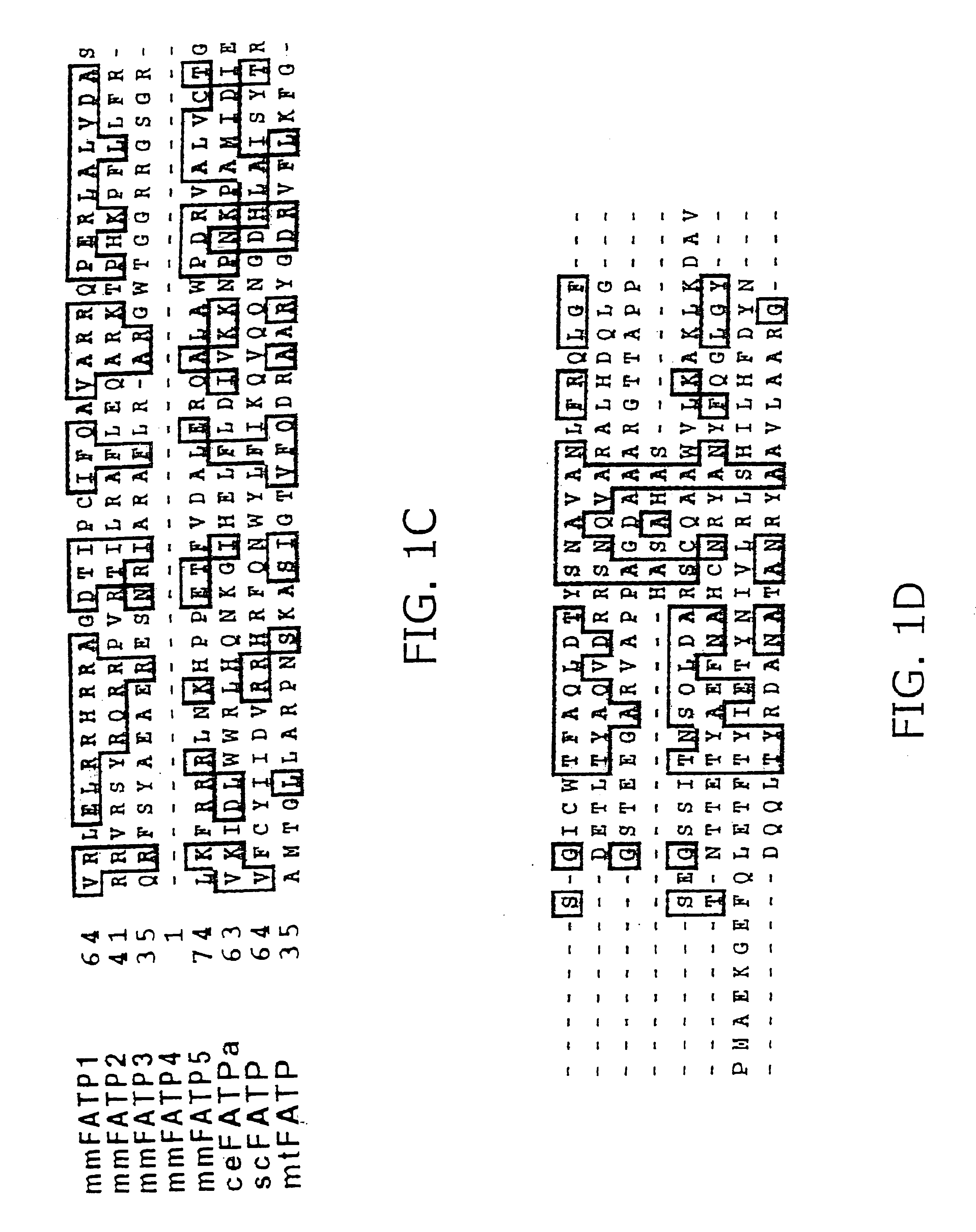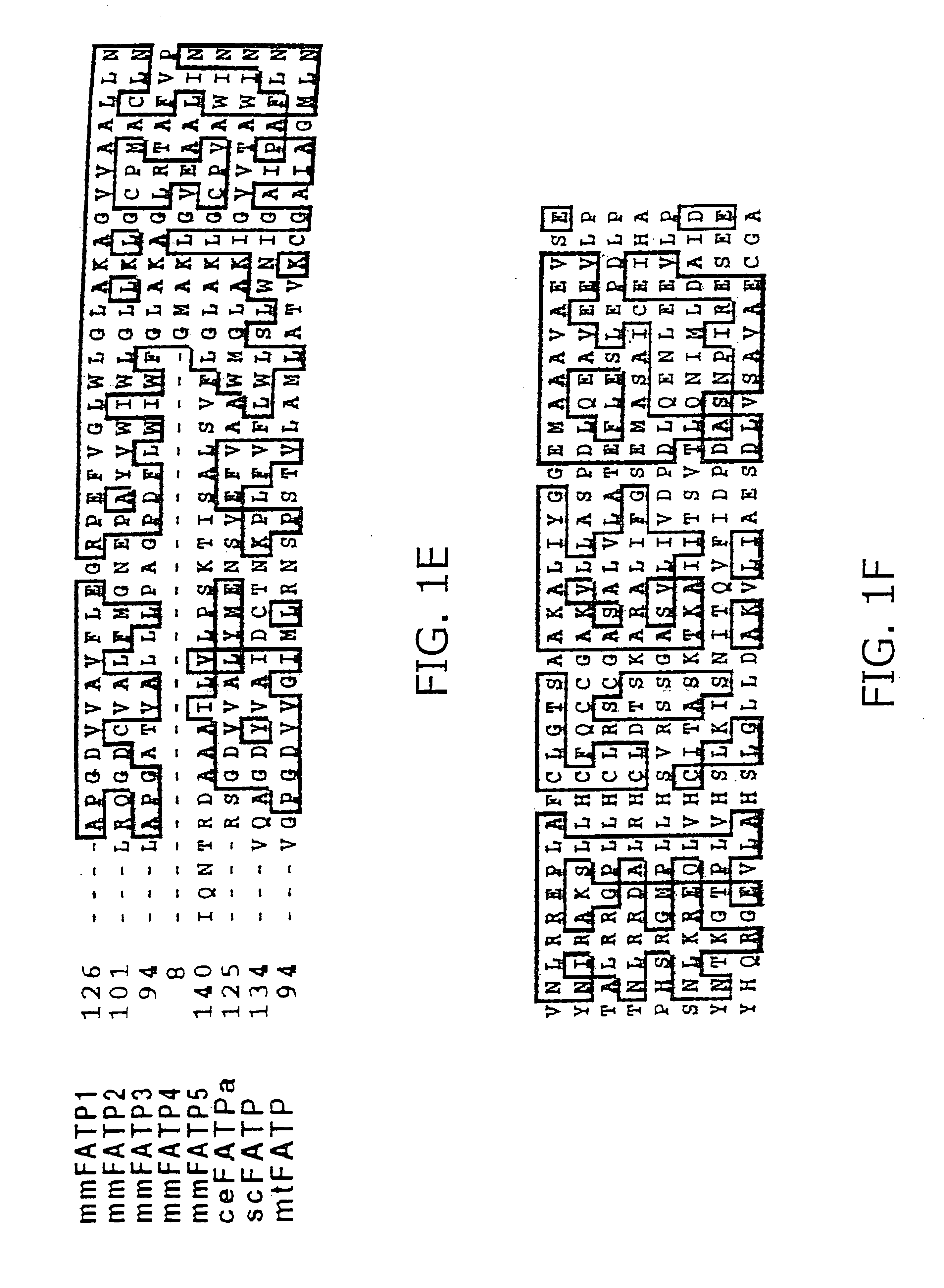Methods of identifying inhibitors of fatty acid transport proteins (FATP)
a technology inhibitor, which is applied in the field of methods of identifying inhibitors of fatty acid transport protein, can solve the problems that non-specific transport cannot account for the high affinity and specific transport of lcfas exhibited by cells such as cardiac muscle, hepatocytes, enterocytes, etc., and achieves the effect of reducing lcfa uptake into heart muscle, enhancing or inhibiting, and high levels
- Summary
- Abstract
- Description
- Claims
- Application Information
AI Technical Summary
Benefits of technology
Problems solved by technology
Method used
Image
Examples
example 1
Identification of Novel Mammalian FATPs
[0250]The National Center for Biotechnology Information EST database was screened, using the mouse PATP protein sequence (mmFATP1), to identify novel FATPs. This strategy led to the identification of more than 50 murine EST sequences which could be assembled into five distinct contiguous DNA sequences (contigs). One contig was identical to the previously cloned FATP, which has been renamed FATP1. Another, which has been renamed FATP2, is the murine homologue of a rat gene previously identified by others as a very long chain acyl-CoA synthase (Uchiyama, A., Aoyama, T., Kamijo, K., Uchida, Y., Kondo, N., Orii, T. & Hashimoto, T. (1996) J. Biol. Chem. 271:30360-30365). The other three contigs represented novel genes (FATP3, 4, and 5). Full-length clones for FATP2 and FATP5 and nearly complete sequences for FATP3 and 4 (FIG. 1) were obtained by screening cDNA libraries made from mouse day 10.5 embryos and adult liver. Also identified were human hom...
example 2
Assessment of Function
[0256]The ability of the newly identified mouse genes to function as fatty acid transporters was assessed using a fluorescence-activated cell sorting-based assay. COS cells were transiently cotransfected with expression vectors encoding the cell surface protein CD2 and either mmFATP1, mmFATP2, or mmFATP5, respectively. Two days after transfection, COS cells were stained with an antibody to CD2 and then incubated with a BODIPY-labeled fatty acid [BODIPY-FA, (Schaffer, J. E. & Lodish, H. F. (1994) Cell 79:427-436)]. The cells were then washed extensively, lifted off the dish, and analyzed by fluorescence-activated cell sorting. As judged by the number of CD2-positive cells, the transfection efficiency was approximately 20-30%. Fatty acid uptake was quantitated in the transiently transfected COS cells by measuring the BODIPY-FA fluorescence of the CD2-positive cells. Expression of CD2 had no effect on fatty acid uptake as shown by the finding that COS cells expres...
example 3
Expression Patterns of Murine FATPs
[0257]Expression patterns of members of the murine FATP gene family were characterized by Northern blot analysis; to avoid cross-hybridization, the probes used were from the 3′ untranslated region of these genes, which are less than 60% identical in sequence. The expression pattern of FATP1 agrees with that previously found (Schaffer, J. E. & Lodish, H. F. (1994) Cell 79:427-436). Here, expression was seen primarily in heart and kidney. FATP2 is expressed almost exclusively in liver and kidney, which corresponds to the reported tissue distribution of the rat homologue [very long chain acyl-CoA (VLACS)] as assessed by Western blotting (Uchiyama, A., Aoyama, T., Kamijo, K., Uchida, Y., Kondo, N., Orii, T. & Hashimoto, T. (1996) J. Biol. Chem. 271:30360-30365). FATP3 is present in lung, liver, and testis. FATP5 is expressed only in liver and cannot be detected in other tissues even when the blot is overexposed. The human homologue of FATP5 is also liv...
PUM
| Property | Measurement | Unit |
|---|---|---|
| time | aaaaa | aaaaa |
| Tm | aaaaa | aaaaa |
| Tm | aaaaa | aaaaa |
Abstract
Description
Claims
Application Information
 Login to View More
Login to View More - R&D
- Intellectual Property
- Life Sciences
- Materials
- Tech Scout
- Unparalleled Data Quality
- Higher Quality Content
- 60% Fewer Hallucinations
Browse by: Latest US Patents, China's latest patents, Technical Efficacy Thesaurus, Application Domain, Technology Topic, Popular Technical Reports.
© 2025 PatSnap. All rights reserved.Legal|Privacy policy|Modern Slavery Act Transparency Statement|Sitemap|About US| Contact US: help@patsnap.com



